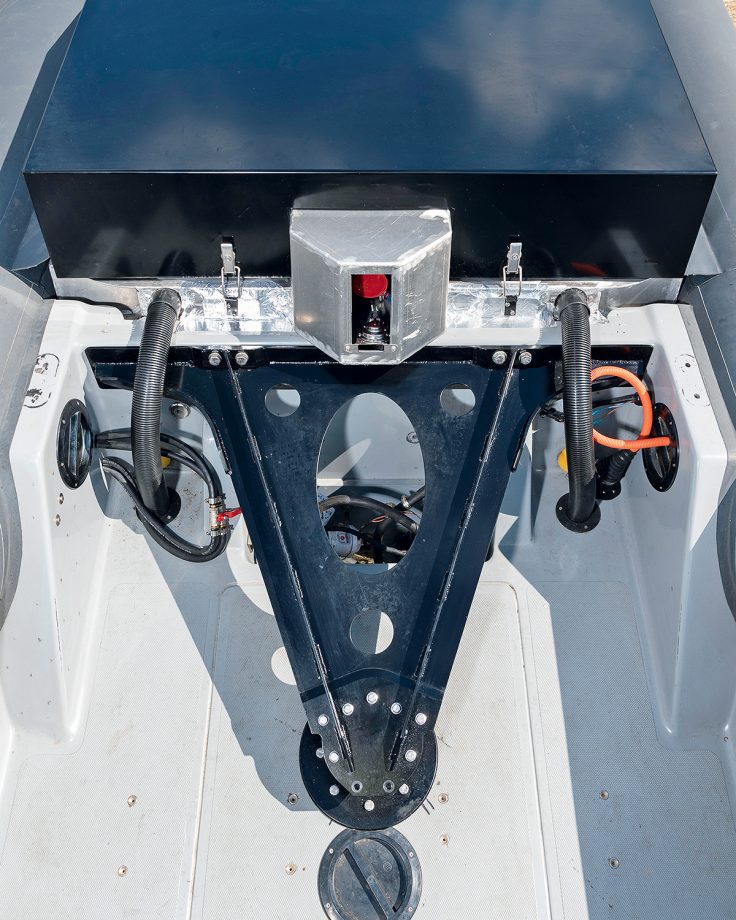Mathwall Marine believes the future of clean propulsion lies not in inboards or outboards but something in-between. Jack Frith takes a closer look at the new bolt-on multi-fuel electric Halfboard...
How many methods of powered marine propulsion are in regular use today? Other than a handful of oddities, the vast majority of them are either inboard (linked to a shaft, pod, jet, surface or sterndrive system) or outboard.
UK company Mathwall Marine, however, has recently patented a technology that’s neither of the above. Named the Halfboard due to its half inboard and half outboard nature, it aims to combine the versatility and ease of replacement of an outboard with the more generous engine space and neater looks of an inboard.
The reason this could prove invaluable to boat builders is because of the extra space needed for complex hybrid and multi-fuel engines.
The CHAMP Project (Clean Hybrid Alternative Marine Powertrains), led by Mathwall Marine and funded by Innovate UK as part of the Government’s clean marine competition, led to the development of the Halfboard.
Effectively the engine, electric motor and all its ancillaries are housed inside a watertight box that is then attached to the back of the boat in much the same way as an outboard engine.
Article continues below…

Volvo Penta D4 Hybrid first look: Is this the future of boat propulsion?

Cleaner boating fuels: 5 diesel alternatives that could outperform batteries
However, rather than having a one-size-fits-all engine casing hanging off the transom, the bottom of the Halfboard’s housing is shaped to follow the hull’s existing lines so that it becomes an extension of the planing surface with its own internal buoyancy.
A Mercury sterndrive leg is already bolted onto the halfboard’s own ‘transom’ to transmit power into the water.
The advantage of the Halfboard solution is that it allows room for much larger, more complex drivetrains than could ever fit inside a standard outboard engine housing. The first Halfboard prototype has been fitted to a Ballistic RIB so sea trials can start in earnest.

The prototype Halfboard Ballistic RIB
Dual fuel
This first unit is a parallel hybrid electric engine, and a dual fuel one at that. It can run on battery power, petrol, methanol or any combination of these three.
The advantage of methanol is that it’s a carrier fuel for hydrogen, which releases only water vapour and CO2 when burnt and can be produced sustainably.
Using battery power alone the range is still very limited at the moment, “across the full length of Portsmouth Harbour and back”, is Mathwall’s current estimate, but the GM 450hp LS3 V8 petrol engine (as used in a Corvette sportscar) ensures it also has the performance and range of an offshore RIB.

The hybrid drivetrain runs on petrol, methanol or electricity
Mathwall CEO Mark Mathieson MBE has a vision of how small, fast boats can tackle the energy transition and it certainly isn’t built around full electrification. “We ran the numbers for electrification at the very first stage of the process,” says Mark.
“Sadly we are many years away from a battery electric vessel being able to meet the usage profile of a fast, planing, seagoing powerboat.
“Just as in the automotive sector, we believe that manufacturers have a duty to provide low or zero carbon alternative systems that can equal or better the performance of legacy technologies. Otherwise they just won’t get the take-up we need.”

Helm controls are the same as any other RIB
Hypercar masterclass
Mark has first-hand knowledge of this from the automotive sector having worked as the chief powertrain engineer for McLaren Cars during the development of the P1 hypercar.
The P1 is a PHEV (Plug-in Hybrid Electric Vehicle) with over 900hp on tap and a top speed of 217mph that uses its electric motor to boost performance rather than as a primary means of propulsion.
These days Mathieson’s day job is designing and building racing car engines. This demands continuous rapid development, running engines on methanol, state-of-the-art monitoring systems and treating the powertrain as a self-contained sub-system that can be rapidly bolted to and unbolted from the car.

Standard Mercury Bravo One XR leg provides propulsion
Many of these principles have been applied to the Halfboard concept. As Mark explains: “It has to be easy to re-engineer existing boats with cleaner, hybrid propulsion systems. If the energy transition requires throwing away otherwise perfectly good hulls, then that is just creating another problem.”
Standardisation focus
The company is not claiming that the Halfboard is as easy to install as an outboard engine; each one will have to be adapted to the hull in question. However, the basic principle of an add-on extension that can house an off-the-shelf hybrid propulsion package still makes good sense, especially one that offsets the extra weight of the motor, batteries and dual fuel capabilities with its own internal buoyancy and dynamic lift. Standardisation across different models would help to make it more viable.
It’s still early days, with just one prototype running tests on the water, but the potential of the Halfboard is clear and Mathwall is now seeking partnerships with boatbuilders and commercial users to develop it further.
The hope is that before long a pre-production prototype of a high-performance luxury sportscruiser with a hybrid methanol/electric Halfboard could soon become the world’s first truly carbon-neutral powerboat.

Extended tubes add buoyancy while angled support helps spread the load












